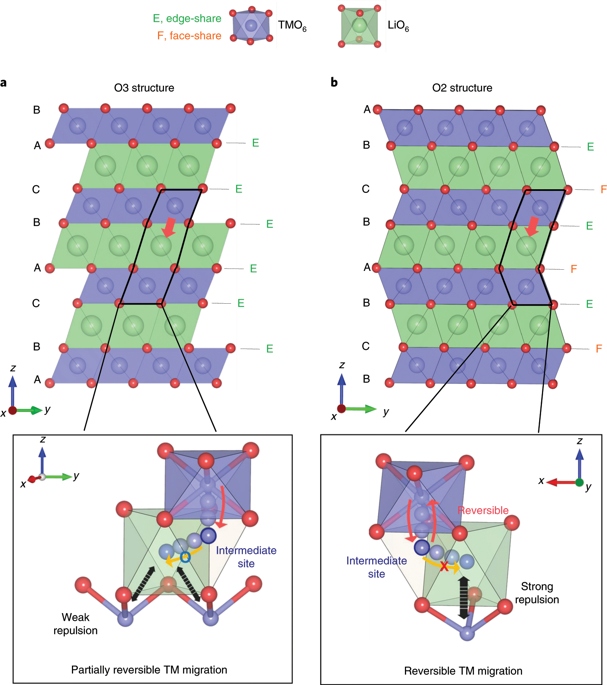Nature Materials ( IF 37.2 ) Pub Date : 2020-01-20 , DOI: 10.1038/s41563-019-0572-4 Donggun Eum , Byunghoon Kim , Sung Joo Kim , Hyeokjun Park , Jinpeng Wu , Sung-Pyo Cho , Gabin Yoon , Myeong Hwan Lee , Sung-Kyun Jung , Wanli Yang , Won Mo Seong , Kyojin Ku , Orapa Tamwattana , Sung Kwan Park , Insang Hwang , Kisuk Kang

|
Despite the high energy density of lithium-rich layered-oxide electrodes, their real-world implementation in batteries is hindered by the substantial voltage decay on cycling. This voltage decay is widely accepted to mainly originate from progressive structural rearrangements involving irreversible transition-metal migration. As prevention of this spontaneous cation migration has proven difficult, a paradigm shift toward management of its reversibility is needed. Herein, we demonstrate that the reversibility of the cation migration of lithium-rich nickel manganese oxides can be remarkably improved by altering the oxygen stacking sequences in the layered structure and thereby dramatically reducing the voltage decay. The preeminent intra-cycle reversibility of the cation migration is experimentally visualized, and first-principles calculations reveal that an O2-type structure restricts the movements of transition metals within the Li layer, which effectively streamlines the returning migration path of the transition metals. Furthermore, we propose that the enhanced reversibility mitigates the asymmetry of the anionic redox in conventional lithium-rich electrodes, promoting the high-potential anionic reduction, thereby reducing the subsequent voltage hysteresis. Our findings demonstrate that regulating the reversibility of the cation migration is a practical strategy to reduce voltage decay and hysteresis in lithium-rich layered materials.
中文翻译:

富锂层状氧化物电极中可逆阳离子迁移的电压衰减和氧化还原不对称缓解
尽管富锂层状氧化物电极的能量密度很高,但它们在电池中的实际应用受到循环时电压衰减的阻碍。这种电压衰减被广泛认为主要源于涉及不可逆过渡金属迁移的渐进结构重排。由于预防这种自发的阳离子迁移已被证明是困难的,因此需要向管理其可逆性的范式转变。在这里,我们证明了通过改变层状结构中的氧堆积顺序,可以显着提高富锂镍锰氧化物的阳离子迁移的可逆性,从而显着降低电压衰减。阳离子迁移的卓越的循环内可逆性通过实验可视化,第一性原理计算表明,O2型结构限制了Li层内过渡金属的运动,有效地简化了过渡金属的返回迁移路径。此外,我们提出增强的可逆性减轻了传统富锂电极中阴离子氧化还原的不对称性,促进了高电位阴离子还原,从而减少了随后的电压滞后。我们的研究结果表明,调节阳离子迁移的可逆性是减少富锂层状材料中电压衰减和滞后的实用策略。我们建议增强的可逆性减轻传统富锂电极中阴离子氧化还原的不对称性,促进高电位阴离子还原,从而减少随后的电压滞后。我们的研究结果表明,调节阳离子迁移的可逆性是减少富锂层状材料中电压衰减和滞后的实用策略。我们建议增强的可逆性减轻传统富锂电极中阴离子氧化还原的不对称性,促进高电位阴离子还原,从而减少随后的电压滞后。我们的研究结果表明,调节阳离子迁移的可逆性是减少富锂层状材料中电压衰减和滞后的实用策略。











































 京公网安备 11010802027423号
京公网安备 11010802027423号